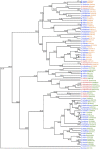Phylogenetic analysis of β-xylanase SRXL1 of Sporisorium reilianum and its relationship with families (GH10 and GH11) of Ascomycetes and Basidiomycetes
- PMID: 27040368
- PMCID: PMC4819176
- DOI: 10.1038/srep24010
Phylogenetic analysis of β-xylanase SRXL1 of Sporisorium reilianum and its relationship with families (GH10 and GH11) of Ascomycetes and Basidiomycetes
Abstract
In this paper, the amino acid sequence of the β-xylanase SRXL1 of Sporisorium reilianum, which is a pathogenic fungus of maize was used as a model protein to find its phylogenetic relationship with other xylanases of Ascomycetes and Basidiomycetes and the information obtained allowed to establish a hypothesis of monophyly and of biological role. 84 amino acid sequences of β-xylanase obtained from the GenBank database was used. Groupings analysis of higher-level in the Pfam database allowed to determine that the proteins under study were classified into the GH10 and GH11 families, based on the regions of highly conserved amino acids, 233-318 and 180-193 respectively, where glutamate residues are responsible for the catalysis.
Figures




Similar articles
-
Molecular cloning and characterization of the novel acidic xylanase XYLD from Bispora sp. MEY-1 that is homologous to family 30 glycosyl hydrolases.Appl Microbiol Biotechnol. 2010 May;86(6):1829-39. doi: 10.1007/s00253-009-2410-0. Epub 2010 Jan 14. Appl Microbiol Biotechnol. 2010. PMID: 20077114
-
Cloning and molecular characterization of a new fungal xylanase gene from Sclerotinia sclerotiorum S2.BMB Rep. 2011 Oct;44(10):653-8. doi: 10.5483/BMBRep.2011.44.10.653. BMB Rep. 2011. PMID: 22026998
-
GH11 xylanases: Structure/function/properties relationships and applications.Biotechnol Adv. 2012 May-Jun;30(3):564-92. doi: 10.1016/j.biotechadv.2011.10.003. Epub 2011 Oct 20. Biotechnol Adv. 2012. PMID: 22067746 Review.
-
Computational approach for identification, characterization, three-dimensional structure modelling and machine learning-based thermostability prediction of xylanases from the genome of Aspergillus fumigatus.Comput Biol Chem. 2021 Apr;91:107451. doi: 10.1016/j.compbiolchem.2021.107451. Epub 2021 Feb 6. Comput Biol Chem. 2021. PMID: 33601238
-
Manganese superoxide dismutase in pathogenic fungi: an issue with pathophysiological and phylogenetic involvements.FEMS Immunol Med Microbiol. 2005 Sep 1;45(3):411-22. doi: 10.1016/j.femsim.2005.06.003. FEMS Immunol Med Microbiol. 2005. PMID: 16055318 Review.
Cited by
-
β-Xylosidase SRBX1 Activity from Sporisorium reilianum and Its Synergism with Xylanase SRXL1 in Xylose Release from Corn Hemicellulose.J Fungi (Basel). 2022 Dec 13;8(12):1295. doi: 10.3390/jof8121295. J Fungi (Basel). 2022. PMID: 36547628 Free PMC article.
-
In silico screening and experimental analysis of family GH11 xylanases for applications under conditions of alkaline pH and high temperature.Biotechnol Biofuels. 2020 Dec 7;13(1):198. doi: 10.1186/s13068-020-01842-5. Biotechnol Biofuels. 2020. PMID: 33372612 Free PMC article.
-
Harnessing Xylanase Potential in Thermothelomyces fergusii: Insights from Computational and Functional Analysis.J Fungi (Basel). 2025 Mar 25;11(4):250. doi: 10.3390/jof11040250. J Fungi (Basel). 2025. PMID: 40278071 Free PMC article.
-
Preparation of β(1→3)/β(1→4) xylooligosaccharides from red alga dulse by two xylanases from Streptomyces thermogriseus.Bioresour Bioprocess. 2021 May 12;8(1):38. doi: 10.1186/s40643-021-00390-6. Bioresour Bioprocess. 2021. PMID: 38650209 Free PMC article.
References
-
- Beg Q. K., Kapoor M., Mahajan L. & Hoondal G. S. Microbial xylanases and their industrial applications: a review. Appl. Microbiol. Biotechnol. 56, 326–338 (2001). - PubMed
-
- Subramaniyan S. & Prema P. Biotechnology of microbial xylanases: enzymology, molecular biology and application. Crit. Rev. Biotechnol. 22, 33–64 (2002). - PubMed
-
- Howard R. L., Abotsi E., Jansen van Rensburg E. L. & Howard S. Lignocellulose biotechnology: issues of bioconversion and enzyme production. Afr. J. Biotechnol. 2, 602–619 (2003).
-
- Polizeli M. L. T. M. et al. Xylanases from fungi: properties and industrial applications. Appl. Microbiol. Biotechnol. 67, 577–591 (2005). - PubMed
-
- Sharma M. & Kumar A. Xylanases: An overview. British. Biotechnol. J. 3, 1–28. (2013).
Publication types
MeSH terms
Substances
LinkOut - more resources
Full Text Sources
Other Literature Sources

